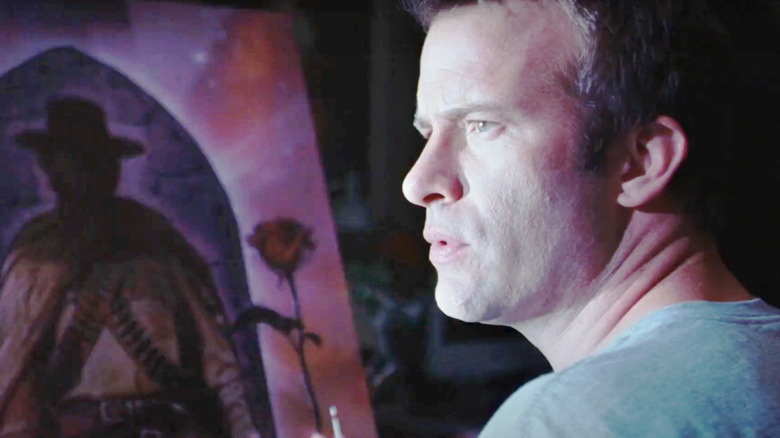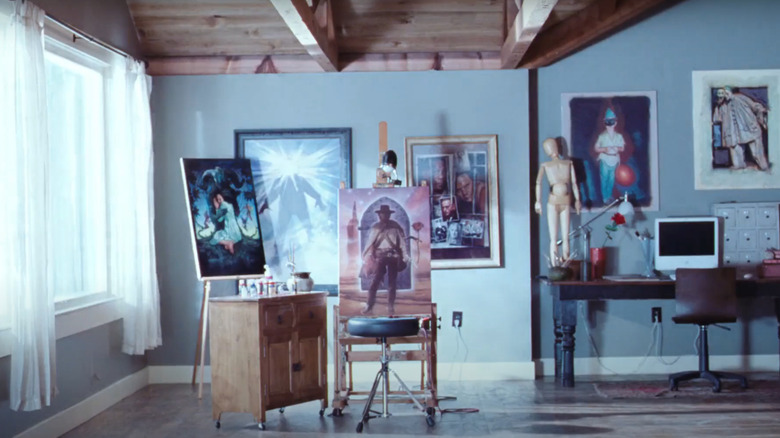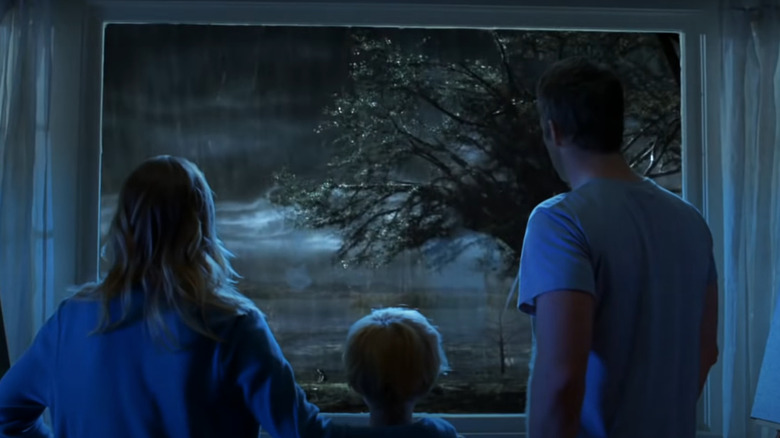Frank Darabont Personally Paid For Drew Struzan To Design Posters For The Mist — Which The Studio Refused To Use [Exclusive]
This post contains spoilers for the ending of "The Mist."
Anyone who's seen "The Mist," Frank Darabont's unsettling take on a 1980 Stephen King novella, will recall the movie's gut-punch of an ending. The 2007 film is best remembered, if alarmingly overlooked, for its bleak denouement, where Thomas Jane's David Drayton kills a group that includes his own son in a suicide pact which turns out to be in vain.
The movie represents a return to a more traditional sci-fi horror that was an interesting change of pace for director Frank Darabont. Prior to "The Mist," Darabont had directed two other Stephen King adaptations in the form of "The Shawshank Redemption" and "The Green Mile" — both of which had posters crafted by the legendary Drew Struzan. The artist is best known for creating one sheets for such movies as "Blade Runner," "Star Wars," and "Indiana Jones," and came to epitomize the look of classic '80s movies with his distinct, hyper-real style.
The prolific painter had such an impact on Darabont that the director based Thomas Jane's character in "The Mist" on Struzan himself. In the opening scene, the camera tracks slowly across Drayton's studio where he sits painting a western figure reminiscent of Stephen King's "Dark Tower" novels. And the artist was also commissioned by Darabont to create original posters for the movie itself. As Eric Vespe discovered while speaking to the director for his all-new oral history of the making of "The Mist," those posters never actually made it to the film's promotional run.
'Here, free posters'
Before "The Mist" debuted, Darabont was eager to bring Struzan in to promote his upcoming movie. His "Green Mile" and "Shawshank Redemption" colleague had created memorable poster designs for those two movies, and Darabont evidently trusted the famed artist to do the same for "The Mist" and its teaser poster. Luckily, it seems the director wasn't disappointed, recalling how Struzan created "two incredible images" for the film, both "very moody" and "beautifully rendered."
The director was so convinced of their quality that he paid for the posters out of his own pocket and printed thousands of them to send to Executive Producer Bob Weinstein, who had greenlit Darabont's project at half the budget he was being offered elsewhere. As Darabont recalled, he passed the Struzan designs to Weinstein, saying:
"Here, free posters. Just send them out to the theaters with whatever you're releasing between now and when our movie comes out. Just send them out. These are cool posters."
Unfortunately, it seems Weinstein and his team at Dimension Films either weren't too impressed with Struzan's work, or felt that the posters should have been left to them because the designs were never used. Darabont puts it down to a sort of "we know what we're doing" attitude among Hollywood executives, which could very well be the case considering Struzan's standing as one of the great poster designers in cinema history. Weinstein and co. must have felt pretty strongly to not use the artist's work — especially considering it was a just a teaser poster and wouldn't have constituted the whole of the movie's promotional material. That, and it was free!
Struzan has become his own form of mythical beast
These days, Struzan's style has enjoyed somewhat of a renaissance. Once digital design methods became popular, his signature style was overshadowed for a time. As Darabont told the Baltimore Sun in 2008: "Most of what passes for movie poster art these days are just Photoshopped pictures of actors striking saucy poses and staring at us like a troop of lobotomy victims."
Thankfully, in the post-"Stranger Things" '80s revival period, new generations of audiences were introduced to Struzan's legendary style. The artist behind posters for everything from "E.T." to "Back to the Future" and even Rambo's inaugural outing in "First Blood" has influenced movie poster design immeasurably, to the point that filmmakers of today are tapping him for work, forcing the legend out of retirement multiple times.
Still, that wasn't enough to convince Bob Weinstein to make use of Struzan's "The Mist" poster, which can be seen on the artist's website. The eventual poster designs opt for a more modern approach which have a certain "Photoshopped" aesthetic of the type Darabont lamented in 2008. But it doesn't seem like it would be too big a deal for Struzan, considering the impressive career he's had. Ultimately, when your posters are almost as iconic as the movies they promote, nothing Bob Weinstein does is likely to bother you.


